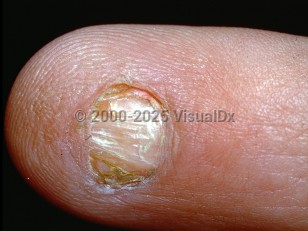Nail-patella syndrome - Nail and Distal Digit
See also in: OverviewAlerts and Notices
Important News & Links
Synopsis
Nail-patella-elbow syndrome is a rare autosomal dominant inherited disease affecting the nails and bones and occurring secondary to a mutation in the LMX1B gene on chromosome 9q34. LMX1B is a LIM-homeodomain transcription factor that is important in limb and glomerular development.
Associated nail changes affect the thumbnails, but often affect all fingernails, with severity decreasing until the fifth digit. Absence of the nail is typical, but hyponychia, especially on the medial side, may also be observed. Lesions are commonly symmetric. Triangular lunulae or V-shaped lunulae are also highly suggestive and typically pathognomonic of the disease. These nail findings are present at birth in almost all cases. Other alterations can include koilonychias, brittle nails, nail splitting, and pterygium.
Toenails are rarely affected. There may be loss of the creases in the skin overlying the distal interphalangeal joint or a complete absence of the joint itself. There is no correlation between the severity of nail disease and systemic involvement.
Moderate to severe patellar dysplasia is seen in 80% of cases, and absent patella is seen in 20% of cases. Pain or gait problems occur following exercise, and patients usually develop early arthritis. Trouble in walking and dislocation of the knee are also possible. Arthrodysplasia of the elbow is observed in 90% of cases secondary to hypoplasia of the radial head leading to limited extension and supination of the elbow. Bilateral posterior iliac crest exostoses (horns) are palpable in 70% of cases and demonstrated on x-ray in 80% of cases. Other possible findings include scoliosis, pas planus, pectus excavatum, short stature, and clubfoot.
Renal dysfunction, eye abnormalities (glaucoma, ocular hypertension), and hearing loss can also occur. Renal involvement is the most worrisome systemic association and may occur in 30%-40% of patients. The most common findings are proteinuria, hematuria, hypertension, and nephrotic syndrome. End-stage renal disease is rare.
Associated nail changes affect the thumbnails, but often affect all fingernails, with severity decreasing until the fifth digit. Absence of the nail is typical, but hyponychia, especially on the medial side, may also be observed. Lesions are commonly symmetric. Triangular lunulae or V-shaped lunulae are also highly suggestive and typically pathognomonic of the disease. These nail findings are present at birth in almost all cases. Other alterations can include koilonychias, brittle nails, nail splitting, and pterygium.
Toenails are rarely affected. There may be loss of the creases in the skin overlying the distal interphalangeal joint or a complete absence of the joint itself. There is no correlation between the severity of nail disease and systemic involvement.
Moderate to severe patellar dysplasia is seen in 80% of cases, and absent patella is seen in 20% of cases. Pain or gait problems occur following exercise, and patients usually develop early arthritis. Trouble in walking and dislocation of the knee are also possible. Arthrodysplasia of the elbow is observed in 90% of cases secondary to hypoplasia of the radial head leading to limited extension and supination of the elbow. Bilateral posterior iliac crest exostoses (horns) are palpable in 70% of cases and demonstrated on x-ray in 80% of cases. Other possible findings include scoliosis, pas planus, pectus excavatum, short stature, and clubfoot.
Renal dysfunction, eye abnormalities (glaucoma, ocular hypertension), and hearing loss can also occur. Renal involvement is the most worrisome systemic association and may occur in 30%-40% of patients. The most common findings are proteinuria, hematuria, hypertension, and nephrotic syndrome. End-stage renal disease is rare.
Codes
ICD10CM:
Q87.2 – Congenital malformation syndromes predominantly involving limbs
SNOMEDCT:
22199006 – Nail-patella syndrome
Q87.2 – Congenital malformation syndromes predominantly involving limbs
SNOMEDCT:
22199006 – Nail-patella syndrome
Look For
Subscription Required
Diagnostic Pearls
Subscription Required
Differential Diagnosis & Pitfalls

To perform a comparison, select diagnoses from the classic differential
Subscription Required
Best Tests
Subscription Required
Management Pearls
Subscription Required
Therapy
Subscription Required
References
Subscription Required
Last Reviewed:04/13/2019
Last Updated:03/22/2022
Last Updated:03/22/2022
Nail-patella syndrome - Nail and Distal Digit
See also in: Overview
